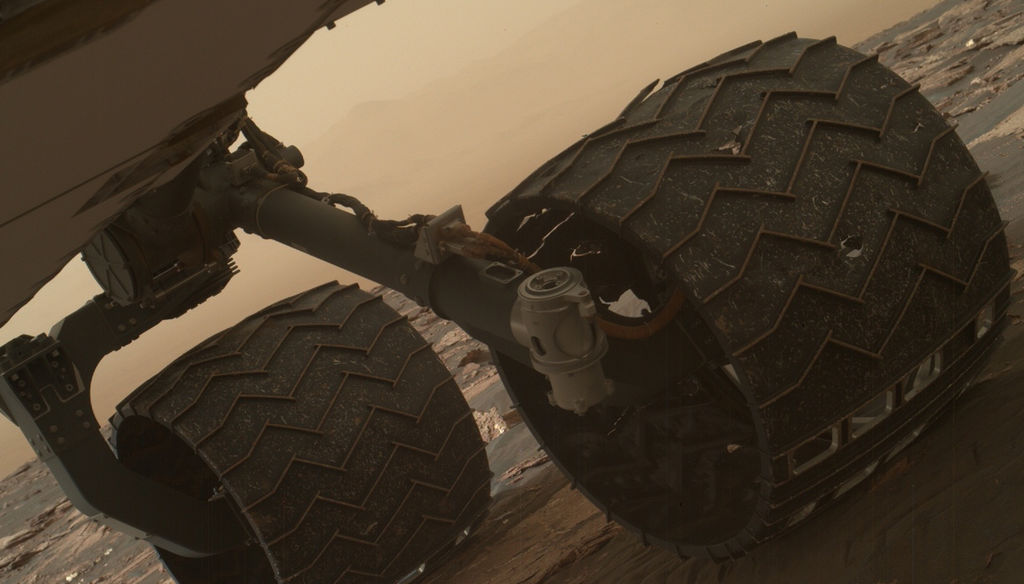
As the Curiosity rover continues its traverse among the buttes and sand dunes of Gale crater, you would expect to see some wear and tear after a few years. The rover’s wheels have naturally taken the brunt of that, with small dents and holes appearing in the solid aluminum. But now, new damage has been seen for the first time, breaks in the raised treads on the wheels, called grousers. While not unexpected, and not a mission-stopper by any means, it does show how the wheels, and the rover overall, have been aging since landing in 2012.
“All six wheels have more than enough working lifespan remaining to get the vehicle to all destinations planned for the mission,” said Curiosity Project Manager Jim Erickson at NASA’s Jet Propulsion Laboratory, Pasadena, California. “While not unexpected, this damage is the first sign that the left middle wheel is nearing a wheel-wear milestone.”
The breaks were discovered during a routine check of the six wheels on the rover, in images taken on March 19. This is the first time that breaks have been seen in the grousers, and they occurred sometime since the last wheel check on Jan. 27. Despite these, the rover is still fully capable of continuing its journey. Back in 2013, the first dents and holes were seen to be accumulating faster than initially expected, but then the terrain has been very rocky and rough in some areas, where small sharp rocks could dent or punch small holes into the aluminum. Previous testing on Earth showed that after three grousers have broken on a wheel, then that wheel has probably reached about 60 percent of its lifetime. So far, it’s still only two, on one wheel, and engineers are confident that Curiosity will be able to accomplish all of its science goals as it continues farther up the slopes of Mount Sharp. So far, the rover has driven nearly 10 miles (16 kilometers) since landing.
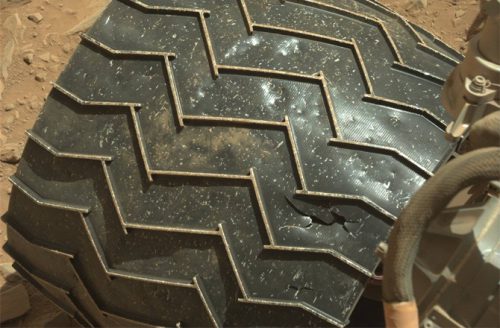
As Curiosity Project Scientist Ashwin Vasavada also explained, “This is an expected part of the life cycle of the wheels and at this point does not change our current science plans or diminish our chances of studying key transitions in mineralogy higher on Mount Sharp.”
That’s a relief, since Curiosity has been making some incredible discoveries, and scientists expect more on the mountain.
Aluminum may not seem like the best material to make the wheels out of, but engineers designed them that way on purpose, keeping them lightweight but still strong enough to handle the travel. Each of Curiosity’s six wheels is about 20 inches (50 centimeters) in diameter and 16 inches (40 centimeters) wide, and they are milled out of solid aluminum. The wheels also have a “skin” that’s about half as thick as a U.S. dime, except in spots with thicker treads. The grousers are composed of 19 zigzag-shaped treads that extend about a quarter-inch (three-fourths of a centimeter) outward from the skin of each wheel. These grousers bear a lot of the rover’s weight as well as provide most of the traction and ability to traverse over difficult, uneven terrain.
Apart from the wheel problems, the rover has kept busy with its science observations. As announced this week at the Lunar and Planetary Science Conference (LPSC) in Texas, Curiosity has observed its first clouds shaped by gravity waves. Gravity waves are created when some unknown feature of the landscape causes a ripple in the atmosphere that is then seen in clouds. According to John Moores, a planetary scientist at York University in Toronto, these formations can also help scientists estimate ground ice depth and possibly recurring slope lineae, which are potentially flows of briny/salty water on the surface.
“If we wish to understand the water story of Mars’s past,” Moores said, “we first need to [separate out] contributions from the present-day water cycle.”
Mars has clouds of both water vapor and carbon dioxide – cirrus-like water clouds form around the equatorial region, while above the poles, carbon dioxide clouds tend to be seen. These cloud systems form when Mars drifts toward aphelion – the point when the planet is farthest from the Sun in its orbit.
Moores and his team recorded eight-frame movies of such wispy cirrus-like cloud belts above Curiosity for two martian years; the images were taken by the rover’s Navcam camera. The cloud formations are very thin, so they can only be seen easily in computer enhancements.
As of right now, Curiosity is studying some more sand dune formations, which are part of the Bagnold Dunes dune field which wraps partway around the base of Mount Sharp. Later, the rover will travel to “Vera Rubin Ridge,” a clay-containing geological unit above that ridge, and a sulfate-containing unit above the clay unit. These formations will help scientists understand the history of water in Gale crater, which at one time was a lake.
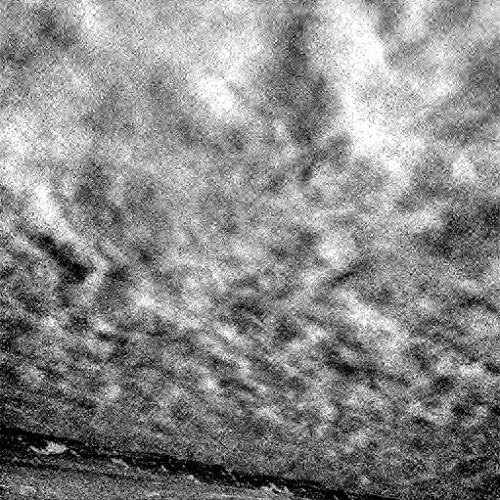
As also discussed at LPSC, Curiosity has found high levels of manganese oxides in some of the rocks it has studied, as has the Opportunity rover. This is interesting, since on Earth, manganese oxides form in oxidizing environments with liquid water. They are also associated with microbial activity, although there are other ways they can form as well. As noted by Tanya Harrison on Twitter, quoting Nina Lanza:
“Mn oxides form in strongly oxidizing environments w/liquid water on Earth, closely associated w/biological activity.”
“We don’t see high concentrations of Mn oxides in the rock record on Earth until the rise of photosynthesis.”
Whether or not the data from Curiosity so far can determine whether the manganese oxides could be the result of ancient microbial activity, or not, isn’t known yet. As Lanza responded:
“Too early to tell, need lots more lab data to confirm trends.”
The Curiosity results will continue to be studied, and perhaps more clues will be found as to the origin of the manganese oxide deposits. Even better, the upcoming Mars 2020 rover will have more sophisticated equipment to examine these or other kinds of possible biosignatures. It’s an intriguing finding, but it takes time to do proper scientific analysis, and Curiosity wasn’t designed to specifically look for evidence of life itself, but rather habitable environments in the distant past, which it has already found.
It was also recently reported that Curiosity’s findings about ancient water on Mars have created a paradox of sorts; the rover has found abundant evidence for ancient lakes in Gale crater, but at the same time has not yet found evidence for a previous thicker atmosphere with more carbon dioxide, which had been more or less assumed and normally would be required for water to remain liquid on the surface. These two lines of evidence seem to contradict each other.
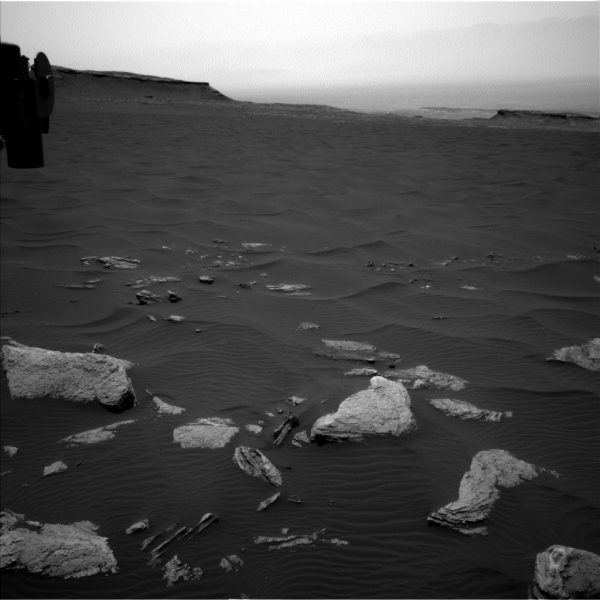
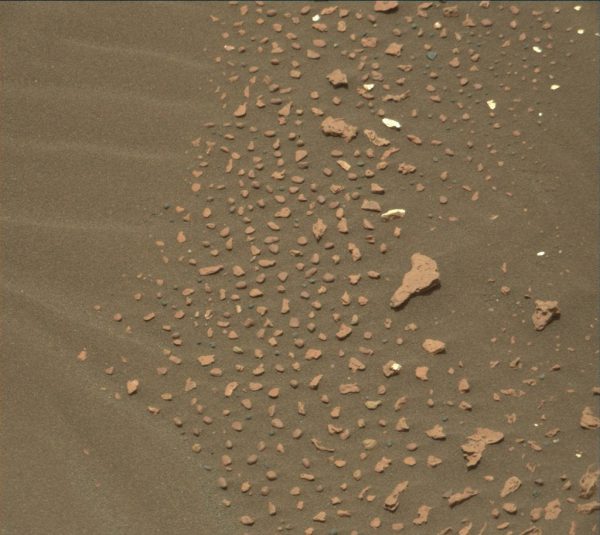
So how do scientists resolve this? It was thought that more carbonates would be discovered than actually have been. On Earth, carbon dioxide combines with positively charged ions such as magnesium and ferrous iron to form carbonate minerals. So with all that liquid water, there should be carbonate deposits left behind. But so far, only much lesser amounts than anticipated have been discovered.
“We’ve been particularly struck with the absence of carbonate minerals in sedimentary rock the rover has examined,” said Thomas Bristow of NASA’s Ames Research Center, Moffett Field, California. “It would be really hard to get liquid water even if there were a hundred times more carbon dioxide in the atmosphere than what the mineral evidence in the rock tells us.”
“It’s been a mystery why there hasn’t been much carbonate seen from orbit,” Bristow added. “You could get out of the quandary by saying the carbonates may still be there, but we just can’t see them from orbit because they’re covered by dust, or buried, or we’re not looking in the right place. The Curiosity results bring the paradox to a focus. This is the first time we’ve checked for carbonates on the ground in a rock we know formed from sediments deposited under water.”
Some other possibilities are that there was a denser carbon dioxide atmosphere, but containing molecular hydrogen, or the lakes were covered by a layer of ice, or that bursts of methane may have helped to keep the atmosphere warm enough for liquid water.
These are just some of the fascinating findings so far from Curiosity, and as long as the wheels continue to hold up well enough, there should be more discoveries to look forward to, and maybe even answers to some long-standing mysteries.
More information about the Curiosity mission is available here.
Be sure to “LIKE” AmericaSpace on Facebook and follow us on Instagram & Twitter!




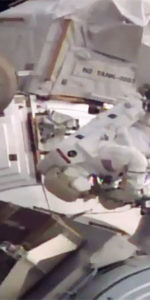
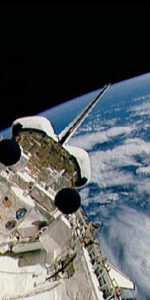
One wonders what the “spare parts” concerts might be for a manned mission to Mars.
“concerns”
Heavy “metal”.